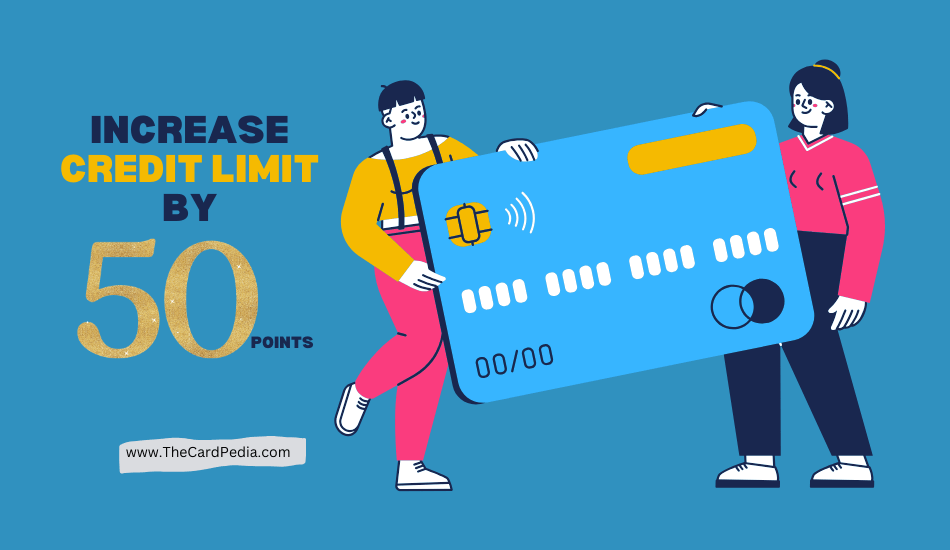Increase Credit Limit for Low Spenders: Do you feel stuck with a low credit limit, despite using your card responsibly? It can hurt your credit score and limit your buying power. But there’s good news! This guide unveils proven strategies to increase your credit limitby 50 points, even if you’re a low-spender. Unlock the secrets to building stronger credit and enjoy the flexibility you deserve!
Understanding Low Credit Utilization and Its Impact
The key to unlocking a higher credit limit lies in low credit utilization. This refers to the percentage of your credit card limit you use. Credit bureaus love to see responsible credit management, and a low credit utilization ratio (ideally below 30%) demonstrates this. Here’s why it matters:
- Low utilization shows you’re not reliant on credit: It signifies you’re financially responsible and don’t overspend.
- It signals you can handle a higher limit: A consistently low utilization ratio tells issuers you can manage a larger credit line responsibly
Credit Limits and Creditworthiness
- Credit Limit: The maximum amount you can borrow on your credit card.
- Credit Utilization Ratio: The percentage of your credit limit you’re currently using. A lower ratio is generally better for your credit score.
Why Low Spenders Might Have Lower Credit Limits
Even with a perfect payment history, low credit card usage can make it harder for issuers to assess your creditworthiness. They might not have enough information to determine how responsibly you’d handle a higher limit.
Building a High Credit Score for Success
A healthy credit score is crucial in securing a credit limit increase. Here are some ways low-spenders can strengthen their scores:
- Pay bills on time consistently: This is the most significant factor influencing your credit score.
- Maintain a good mix of credit: Having a mix of credit cards and installment loans (like auto loans) demonstrates responsible credit management across different types of debt.
- Avoid applying for too much credit at once: Every credit card application triggers a hard inquiry on your credit report, which can temporarily lower your score.
📢 Read More: 7 Essential Credit Card Tips for Beginners in 2024
Steps for Low Spenders to Increase Credit Limit
Even with low spending, you can take proactive steps to convince issuers to raise your credit limit. Here’s what you can do:
1. Maintain a Stellar Credit History
This remains the golden rule. Pay your bills on time, every time. Late payments can significantly damage your credit score and derail your credit limit increase plans.
2. Keep Your Credit Utilization Ratio Low
Aim for a credit utilization ratio below 30%. Even better, strive for below 10%. This demonstrates your ability to manage credit responsibly without maxing out your cards.
3. Request a Credit Limit Increase
- Contact Your Issuer: Most issuers allow you to request a credit limit increase online or by phone.
- Do Your Research: Check if your issuer has a minimum credit history requirement for an increase.
- Time Your Request: Ideally, request an increase after several months of consistent on-time payments and low credit utilization.
- Prepare to Explain: Be ready to explain why you need a higher limit. Maybe you anticipate a larger upcoming expense or want to improve your overall credit utilization.
4. Consider an Automatic Credit Limit Review
Some issuers automatically review accounts periodically and increase limits based on positive credit behavior.
5. Leverage Additional Credit Cards
- Become a Multi-Cardholder: Having multiple cards with responsible usage can show a broader credit history. However, avoid opening too many cards at once, as this can negatively impact your credit score.
- Secured Cards: If you have a limited credit history, consider a secured card. These require an upfront deposit that becomes your credit limit. Using it responsibly can help build your credit score and potentially qualify you for unsecured cards with higher limits later.
📢 Are you a young adult ready to build a solid financial future? Dive into our latest blog, “Secured Credit Cards in 2024: How to Build Your Credit Journey,” packed with expert tips to establish a strong credit score and achieve your financial goals!
6. Rebuild Credit Limit After Inactivity
If your credit card hasn’t been used in a while, your issuer might decrease your limit or even close the account. To rebuild your limit:
- Start Using the Card Again: Make small, regular purchases and pay them off in full each month.
- Contact Your Issuer: Explain your situation and inquire about reactivating your credit line.
Factors Affecting Credit Limit Increase for Low Spenders
Several factors influence a credit card issuer’s decision on credit limit increases. Here are some key considerations for low-spenders:
- Credit History: A long and consistent history of on-time payments demonstrates responsible credit use.
- Credit Score: A good credit score signifies your ability to manage credit responsibly.
- Income: A stable and sufficient income reassures the issuer of your capacity to handle a higher credit limit.
- Credit Utilization Ratio: While a low utilization is positive, consider strategically increasing spending within reasonable limits to showcase your ability to handle a higher credit line.
- Credit card activity: Consistent, responsible credit card use can be viewed positively by issuers.
Tips for Low Spenders to Increase Creditworthiness
Beyond the steps mentioned above, here are some additional tips for low-spenders to improve their creditworthiness:
- Monitor your credit report regularly: Identify and address any errors that could be dragging down your score.
- Dispute any inaccuracies: If you find errors on your credit report, file a dispute with the credit bureau to have them corrected.
- Practice responsible financial management: Maintain a budget, avoid unnecessary debt, and manage your finances responsibly
📢 Check: Free Credit Score Repair Guide: Fix Your Credit, Boost Your Score
Can I Get a Credit Card with a High Starting Limit as a Low Spender?
While some cards target high-spenders with hefty rewards programs, there are options for low spenders. Look for cards with lower credit score requirements and focus on benefits that align with your spending habits, like cash back on everyday purchases.
Best Credit Cards for Low Limit Increases?
Secured credit cards
Secured credit cards require you to put down a security deposit that becomes your credit limit. This is a great way to build your credit history if you have no credit or bad credit.
- Discover it® Secured Credit Card: This card offers a cash-back match bonus in the first year after you spend $500 on purchases in the first 12 months of card membership. Plus, it has a good reputation for graduating to unsecured cards once you’ve built good credit.
- Capital One Quicksilver Secured Mastercard®: This card offers a cash-back bonus on all purchases and has a lower minimum security deposit requirement than some other secured cards.
Student Credit Cards
Student credit cards are typically designed for students with limited credit history. They may have lower credit limit requirements than traditional credit cards.
- Discover it® Student Chrome℠ Card: This card offers a cash-back match bonus in the first year after you spend $500 on purchases in the first 12 months of card membership. It also has no annual fee and student-friendly benefits.
- Deserve Edu Mastercard® for Students: This card rewards streaming services, cellphone bills, and other student-friendly categories. Plus, it offers a security feature that allows you to freeze your card if you misplace it.
Credit Cards with Low Annual Fees
Credit cards with low or no annual fees are typically easier to get approved for than cards with high annual fees.
- Capital One Quicksilver Cash Rewards Mastercard®: This card offers a cash-back bonus on all purchases and has no annual fee.
- PenFed Platinum Rewards Visa® Signature Card:This card offers cash back rewards on groceries and gas, and it has an annual fee that’s waived the first year.
Not all issuers are equal when it comes to credit limit increases. Research cards are known for being more generous with limit increases, especially for users with a history of responsible credit card use.
FAQ: Increasing Credit Limit as a Low Spender
01. Why is my credit limit low even though I’m a responsible cardholder?
02. What’s the deal with low credit utilization?
03. My credit score isn’t the best. How can I improve it as a low-spender?
04. Are there other ways to build credit as a low-spender?
05. What factors besides my efforts affect a credit limit increase?
06. Even if I don’t spend much, what are the benefits of a higher credit limit?
07. Any additional tips for low spenders to improve creditworthiness?
08. What’s the magic number for credit utilization?
At TheCardPedia.com, we’re your trusted guide to mastering credit cards. Explore expert insights, trends, and tips to make savvy financial choices. Start your journey to financial empowerment now!









[…] 🚀 Read More:How to Increase Credit Limit for Low Spenders […]
[…] no balance and haven’t used it in the past 6 months, Wells Fargo may automatically share your credit limit between your existing and new Signify card. This allows you to use both cards without exceeding […]